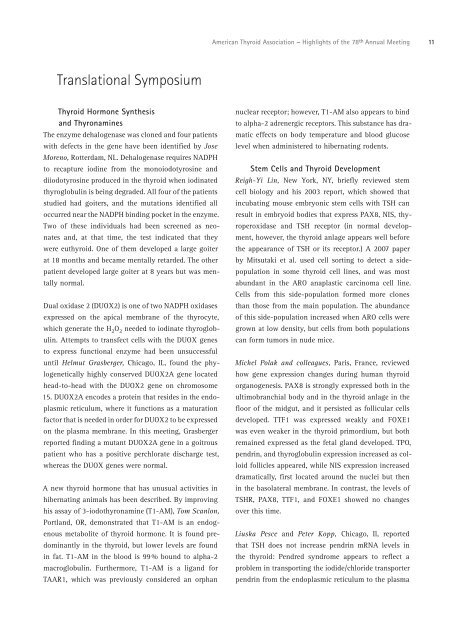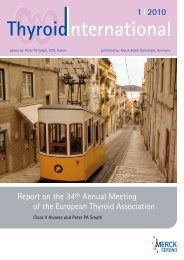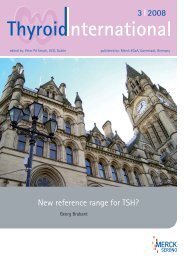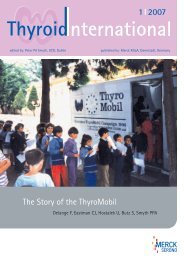Highlights of the 78th Annual Meeting American Thyroid ... - Thyrolink
Highlights of the 78th Annual Meeting American Thyroid ... - Thyrolink
Highlights of the 78th Annual Meeting American Thyroid ... - Thyrolink
You also want an ePaper? Increase the reach of your titles
YUMPU automatically turns print PDFs into web optimized ePapers that Google loves.
<strong>American</strong> <strong>Thyroid</strong> Association – <strong>Highlights</strong> <strong>of</strong> <strong>the</strong> 78 th <strong>Annual</strong> <strong>Meeting</strong>11Translational Symposium<strong>Thyroid</strong> Hormone Syn<strong>the</strong>sisand ThyronaminesThe enzyme dehalogenase was cloned and four patientswith defects in <strong>the</strong> gene have been identified by JoseMoreno, Rotterdam, NL. Dehalogenase requires NADPHto recapture iodine from <strong>the</strong> monoiodotyrosine anddiiodotyrosine produced in <strong>the</strong> thyroid when iodinatedthyroglobulin is being degraded. All four <strong>of</strong> <strong>the</strong> patientsstudied had goiters, and <strong>the</strong> mutations identified alloccurred near <strong>the</strong> NADPH binding pocket in <strong>the</strong> enzyme.Two <strong>of</strong> <strong>the</strong>se individuals had been screened as neonatesand, at that time, <strong>the</strong> test indicated that <strong>the</strong>ywere euthyroid. One <strong>of</strong> <strong>the</strong>m developed a large goiterat 18 months and became mentally retarded. The o<strong>the</strong>rpatient developed large goiter at 8 years but was mentallynormal.Dual oxidase 2 (DUOX2) is one <strong>of</strong> two NADPH oxidasesexpressed on <strong>the</strong> apical membrane <strong>of</strong> <strong>the</strong> thyrocyte,which generate <strong>the</strong> H 2 O 2 needed to iodinate thyroglobulin.Attempts to transfect cells with <strong>the</strong> DUOX genesto express functional enzyme had been unsuccessfuluntil Helmut Grasberger, Chicago, IL, found <strong>the</strong> phylogeneticallyhighly conserved DUOX2A gene locatedhead-to-head with <strong>the</strong> DUOX2 gene on chromosome15. DUOX2A encodes a protein that resides in <strong>the</strong> endoplasmicreticulum, where it functions as a maturationfactor that is needed in order for DUOX2 to be expressedon <strong>the</strong> plasma membrane. In this meeting, Grasbergerreported finding a mutant DUOX2A gene in a goitrouspatient who has a positive perchlorate discharge test,whereas <strong>the</strong> DUOX genes were normal.A new thyroid hormone that has unusual activities inhibernating animals has been described. By improvinghis assay <strong>of</strong> 3-iodothyronamine (T1-AM), Tom Scanlon,Portland, OR, demonstrated that T1-AM is an endogenousmetabolite <strong>of</strong> thyroid hormone. It is found predominantlyin <strong>the</strong> thyroid, but lower levels are foundin fat. T1-AM in <strong>the</strong> blood is 99 % bound to alpha-2macroglobulin. Fur<strong>the</strong>rmore, T1-AM is a ligand forTAAR1, which was previously considered an orphannuclear receptor; however, T1-AM also appears to bindto alpha-2 adrenergic receptors. This substance has dramaticeffects on body temperature and blood glucoselevel when administered to hibernating rodents.Stem Cells and <strong>Thyroid</strong> DevelopmentReigh-Yi Lin, New York, NY, briefly reviewed stemcell biology and his 2003 report, which showed thatincubating mouse embryonic stem cells with TSH canresult in embryoid bodies that express PAX8, NIS, thyroperoxidaseand TSH receptor (in normal development,however, <strong>the</strong> thyroid anlage appears well before<strong>the</strong> appearance <strong>of</strong> TSH or its receptor.) A 2007 paperby Mitsutaki et al. used cell sorting to detect a sidepopulationin some thyroid cell lines, and was mostabundant in <strong>the</strong> ARO anaplastic carcinoma cell line.Cells from this side-population formed more clonesthan those from <strong>the</strong> main population. The abundance<strong>of</strong> this side-population increased when ARO cells weregrown at low density, but cells from both populationscan form tumors in nude mice.Michel Polak and colleagues, Paris, France, reviewedhow gene expression changes during human thyroidorganogenesis. PAX8 is strongly expressed both in <strong>the</strong>ultimobranchial body and in <strong>the</strong> thyroid anlage in <strong>the</strong>floor <strong>of</strong> <strong>the</strong> midgut, and it persisted as follicular cellsdeveloped. TTF1 was expressed weakly and FOXE1was even weaker in <strong>the</strong> thyroid primordium, but bothremained expressed as <strong>the</strong> fetal gland developed. TPO,pendrin, and thyroglobulin expression increased as colloidfollicles appeared, while NIS expression increaseddramatically, first located around <strong>the</strong> nuclei but <strong>the</strong>nin <strong>the</strong> basolateral membrane. In contrast, <strong>the</strong> levels <strong>of</strong>TSHR, PAX8, TTF1, and FOXE1 showed no changesover this time.Liuska Pesce and Peter Kopp, Chicago, Il, reportedthat TSH does not increase pendrin mRNA levels in<strong>the</strong> thyroid: Pendred syndrome appears to reflect aproblem in transporting <strong>the</strong> iodide/chloride transporterpendrin from <strong>the</strong> endoplasmic reticulum to <strong>the</strong> plasma






